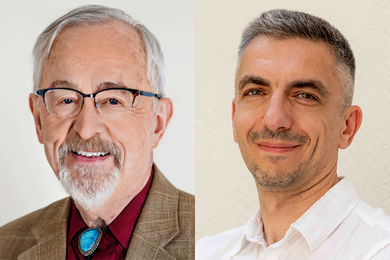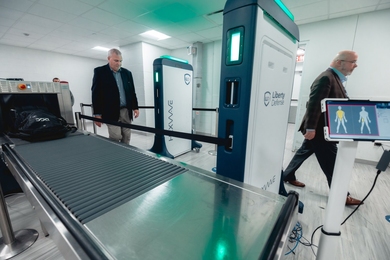In early October, 12 members of MIT’s Solar Electric Vehicle Team (SEVT) boarded planes bound for Darwin, Australia — the departure city of the 2011 Veolia World Solar Challenge (WSC). Held every two years, the World Solar Challenge (WSC) attracts solar electric vehicle teams from around the world, many of whom have spent years building, testing and preparing their solar car for the event. Beginning in Darwin, teams raced 1,864 miles south to Adelaide from Oct. 16 through Oct. 22.
Thirty-six teams competed in this year’s challenge including MIT’s SEVT, captained by MIT senior Alejandro Arambula and Rachel Batzer ’11. Joining them were junior Michael Buchman, Kai Cao ’11, senior George Hansel, Alexander Hayman ’09, junior Alix de Monts, Chris Pentacoff ’06, seniors Lauren Chai and Kelly Ran ’11, junior Adam Delton, sophomore Bruce Arensen, Simon Calcutt ’09, as well as Rachel’s parents, Andy and Annette Batzer.
This year’s challenge was particularly challenging. Their troubles began in the summer, four months prior to the WSC. After three days of successful road testing, including a day at platinum sponsor 3M’s test track and on the highway in Iowa, SEVT’s vehicle Chopper del Sol crashed. While the driver was unharmed, Chopper del Sol endured significant lower body damage forcing the team to rebuild their vehicle. A summer originally meant for test-driving and data collection turned into a stressful summer filled with numerous 16-hour workdays in Building N51 on the MIT campus, the workspace for student clubs and teams supported by the Edgerton Center.
The hard work paid off and Chopper del Sol was up and running in time for the WSC. After filling out extensive paperwork to ensure that their lithium-ion battery pack, considered a "dangerous good," could be flown directly to Darwin, team members readied their bags, printed their boarding passes, and headed down under. Unfortunately their battery pack did not follow. After a flurry of phone calls with the shipping company, the team — with only 38 hours before the race — realized that they had two choices:
de Monts describes the situation as humbling. SEVT members went to each of the competing teams, asking if they had materials for a back-up pack. The University of Michigan Solar Car Team rose to the occasion, generously donating their extra, unassembled battery pack. The team pulled out their spare battery management system, including extra boards and circuitry from the previous car, and, undaunted, got to work.
“That was a really intense night,” de Monts says. “We got spare battery modules around 8 p.m., and we finished building the pack at 11 a.m. the next morning, just in time for the competition’s Chief Scrutineers’ 11:30 a.m. visit. At noon, we — very conservatively — ran the timed trial that determined starting order.” Fortunately, there were no mishaps, and the team used their blog to give the Michigan team a grateful shout out.
As race day drew closer, SEVT unveiled its secret weapon: red solid urethane tires, the product of a collaboration between SEVT and its sponsors Spracher Engineering, HSMWorks and TWT Group. Having received the tires a day prior to leaving the United States, SEVT used their pre-race time in Darwin to run some preliminary tests on the tires. Everything went well, and come race day, the team had high hopes for their innovative wheels.
Unfortunately, the tires too proved to be another challenge and failed about 10 miles into the race. Reluctantly the team switched to moped tires similar to their competitors, losing the advantage that the lower rolling resistance of the urethane tires would have afforded. Alix calls it a “manufacturing rather than a design defect,” adding that SEVT plans to continue developing these tires. Though the tires were not functional, they drew a lot of media attention at the event and, if future iterations of the tires prove successful, the tires could hit the open solar electric vehicle market in the future.
After switching to moped tires, SEVT revamped its race strategy. Knowing they were out of the running for a top finish, the team used the race as an opportunity to test out new techniques. The daily race period ran from 8 a.m. to 5 p.m. Team members woke up at 5:30 a.m. to charge the solar car battery from the rising sun and prepare for the race. SEVT members were split up amongst three cars: a lead vehicle, which stayed about 200 feet in front of the solar car and warned other team members about upcoming obstacles; Chopper del Sol; and a chase vehicle that remained behind the solar car, giving out orders, taking care of necessary repairs, coordinating with other teams, and monitoring solar car data. After seven days of racing, MIT’s SEVT made it to the finish line, finishing 15th in the overall competition.
SEVT members are understandably a little disappointed about their race performance, having spent two years preparing for the WSC. Still, de Monts points out some highlights of the trip: “It was two weeks of adrenaline, perseverance and ingenuity.” She points out that a fun part was meeting all the other solar car teams; 21 different countries were represented.
“Each team has different designs and team structures. The MIT team was definitely the team with the most women — and we are all engineers!”
She adds that the team, despite all the difficulties endured over the last six months, remains a tight-knit group. “We’re working hard with our sponsors and recruiting new members. We really want to prove that we have a winning solar car.” The team is currently making preparations and modifications to Chopper del Sol to race in the American Solar Challenge this summer.
SEVT’s Platinum and Gold Sponsors are Konica Minolta, Ford, Infinesse, 3M, MIT Edgerton Center, Exa, the MIT Department of Mechanical Engineering and HSMWork.
Thirty-six teams competed in this year’s challenge including MIT’s SEVT, captained by MIT senior Alejandro Arambula and Rachel Batzer ’11. Joining them were junior Michael Buchman, Kai Cao ’11, senior George Hansel, Alexander Hayman ’09, junior Alix de Monts, Chris Pentacoff ’06, seniors Lauren Chai and Kelly Ran ’11, junior Adam Delton, sophomore Bruce Arensen, Simon Calcutt ’09, as well as Rachel’s parents, Andy and Annette Batzer.
This year’s challenge was particularly challenging. Their troubles began in the summer, four months prior to the WSC. After three days of successful road testing, including a day at platinum sponsor 3M’s test track and on the highway in Iowa, SEVT’s vehicle Chopper del Sol crashed. While the driver was unharmed, Chopper del Sol endured significant lower body damage forcing the team to rebuild their vehicle. A summer originally meant for test-driving and data collection turned into a stressful summer filled with numerous 16-hour workdays in Building N51 on the MIT campus, the workspace for student clubs and teams supported by the Edgerton Center.
The hard work paid off and Chopper del Sol was up and running in time for the WSC. After filling out extensive paperwork to ensure that their lithium-ion battery pack, considered a "dangerous good," could be flown directly to Darwin, team members readied their bags, printed their boarding passes, and headed down under. Unfortunately their battery pack did not follow. After a flurry of phone calls with the shipping company, the team — with only 38 hours before the race — realized that they had two choices:
- Charter their own flight;
- Build their own battery pack.
de Monts describes the situation as humbling. SEVT members went to each of the competing teams, asking if they had materials for a back-up pack. The University of Michigan Solar Car Team rose to the occasion, generously donating their extra, unassembled battery pack. The team pulled out their spare battery management system, including extra boards and circuitry from the previous car, and, undaunted, got to work.
“That was a really intense night,” de Monts says. “We got spare battery modules around 8 p.m., and we finished building the pack at 11 a.m. the next morning, just in time for the competition’s Chief Scrutineers’ 11:30 a.m. visit. At noon, we — very conservatively — ran the timed trial that determined starting order.” Fortunately, there were no mishaps, and the team used their blog to give the Michigan team a grateful shout out.
As race day drew closer, SEVT unveiled its secret weapon: red solid urethane tires, the product of a collaboration between SEVT and its sponsors Spracher Engineering, HSMWorks and TWT Group. Having received the tires a day prior to leaving the United States, SEVT used their pre-race time in Darwin to run some preliminary tests on the tires. Everything went well, and come race day, the team had high hopes for their innovative wheels.
Unfortunately, the tires too proved to be another challenge and failed about 10 miles into the race. Reluctantly the team switched to moped tires similar to their competitors, losing the advantage that the lower rolling resistance of the urethane tires would have afforded. Alix calls it a “manufacturing rather than a design defect,” adding that SEVT plans to continue developing these tires. Though the tires were not functional, they drew a lot of media attention at the event and, if future iterations of the tires prove successful, the tires could hit the open solar electric vehicle market in the future.
After switching to moped tires, SEVT revamped its race strategy. Knowing they were out of the running for a top finish, the team used the race as an opportunity to test out new techniques. The daily race period ran from 8 a.m. to 5 p.m. Team members woke up at 5:30 a.m. to charge the solar car battery from the rising sun and prepare for the race. SEVT members were split up amongst three cars: a lead vehicle, which stayed about 200 feet in front of the solar car and warned other team members about upcoming obstacles; Chopper del Sol; and a chase vehicle that remained behind the solar car, giving out orders, taking care of necessary repairs, coordinating with other teams, and monitoring solar car data. After seven days of racing, MIT’s SEVT made it to the finish line, finishing 15th in the overall competition.
SEVT members are understandably a little disappointed about their race performance, having spent two years preparing for the WSC. Still, de Monts points out some highlights of the trip: “It was two weeks of adrenaline, perseverance and ingenuity.” She points out that a fun part was meeting all the other solar car teams; 21 different countries were represented.
“Each team has different designs and team structures. The MIT team was definitely the team with the most women — and we are all engineers!”
She adds that the team, despite all the difficulties endured over the last six months, remains a tight-knit group. “We’re working hard with our sponsors and recruiting new members. We really want to prove that we have a winning solar car.” The team is currently making preparations and modifications to Chopper del Sol to race in the American Solar Challenge this summer.
SEVT’s Platinum and Gold Sponsors are Konica Minolta, Ford, Infinesse, 3M, MIT Edgerton Center, Exa, the MIT Department of Mechanical Engineering and HSMWork.










